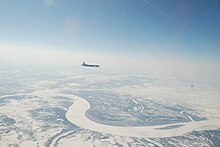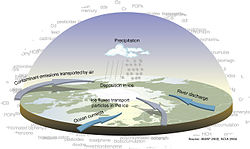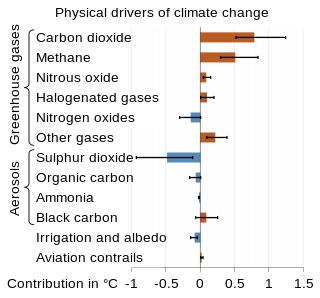
The scientific community has been investigating the causes of climate change for decades. After thousands of studies, it came to a consensus, where it is "unequivocal that human influence has warmed the atmosphere, ocean and land since pre-industrial times." This consensus is supported by around 200 scientific organizations worldwide, The dominant role in this climate change has been played by the direct emissions of carbon dioxide from the burning of fossil fuels. Indirect CO2 emissions from land use change, and the emissions of methane, nitrous oxide and other greenhouse gases play major supporting roles.

Smog, or smoke fog, is a type of intense air pollution. The word "smog" was coined in the early 20th century, and is a portmanteau of the words smoke and fog to refer to smoky fog due to its opacity, and odor. The word was then intended to refer to what was sometimes known as pea soup fog, a familiar and serious problem in London from the 19th century to the mid-20th century, where it was commonly known as a London particular or London fog. This kind of visible air pollution is composed of nitrogen oxides, sulfur oxide, ozone, smoke and other particulates. Man-made smog is derived from coal combustion emissions, vehicular emissions, industrial emissions, forest and agricultural fires and photochemical reactions of these emissions.

In meteorology, an inversion is a phenomenon in which a layer of warmer air overlies cooler air. Normally, air temperature gradually decreases as altitude increases, but this relationship is reversed in an inversion.
The Indian Ocean brown cloud or Asian brown cloud is a layer of air pollution that recurrently covers parts of South Asia, namely the northern Indian Ocean, India, and Pakistan. Viewed from satellite photos, the cloud appears as a giant brown stain hanging in the air over much of the Indian subcontinent and the Indian Ocean every year between October and February, possibly also during earlier and later months. The term was coined in reports from the UNEP Indian Ocean Experiment (INDOEX). It was found to originate mostly due to farmers burning stubble in Punjab and to lesser extent Haryana and Uttar Pradesh. The debilitating air quality in Delhi is also due to the stubble burning in Punjab.

Global cooling was a conjecture, especially during the 1970s, of imminent cooling of the Earth culminating in a period of extensive glaciation, due to the cooling effects of aerosols or orbital forcing. Some press reports in the 1970s speculated about continued cooling; these did not accurately reflect the scientific literature of the time, which was generally more concerned with warming from an enhanced greenhouse effect.

Global dimming is a decline in the amount of sunlight reaching the Earth's surface. It is caused by atmospheric particulate matter, predominantly sulfate aerosols, which are components of air pollution. Global dimming was observed soon after the first systematic measurements of solar irradiance began in the 1950s. This weakening of visible sunlight proceeded at the rate of 4–5% per decade until the 1980s. During these years, air pollution increased due to post-war industrialization. Solar activity did not vary more than the usual during this period.

James Edward Hansen is an American adjunct professor directing the Program on Climate Science, Awareness and Solutions of the Earth Institute at Columbia University. He is best known for his research in climatology, his 1988 Congressional testimony on climate change that helped raise broad awareness of global warming, and his advocacy of action to avoid dangerous climate change. In recent years, he has become a climate activist to mitigate the effects of global warming, on a few occasions leading to his arrest.

Haze is traditionally an atmospheric phenomenon in which dust, smoke, and other dry particulates suspended in air obscure visibility and the clarity of the sky. The World Meteorological Organization manual of codes includes a classification of particulates causing horizontal obscuration into categories of fog, ice fog, steam fog, mist, haze, smoke, volcanic ash, dust, sand, and snow. Sources for particles that cause haze include farming, traffic, industry, windy weather, volcanic activity and wildfires. Seen from afar and depending on the direction of view with respect to the Sun, haze may appear brownish or bluish, while mist tends to be bluish grey instead. Whereas haze often is considered a phenomenon occurring in dry air, mist formation is a phenomenon in saturated, humid air. However, haze particles may act as condensation nuclei that leads to the subsequent vapor condensation and formation of mist droplets; such forms of haze are known as "wet haze".
This is a list of meteorology topics. The terms relate to meteorology, the interdisciplinary scientific study of the atmosphere that focuses on weather processes and forecasting.
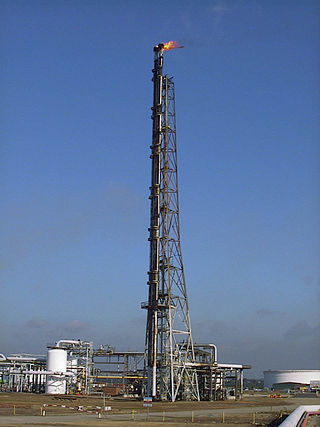
A gas flare, alternatively known as a flare stack, flare boom, ground flare, or flare pit, is a gas combustion device used in places such as petroleum refineries, chemical plants and natural gas processing plants, oil or gas extraction sites having oil wells, gas wells, offshore oil and gas rigs and landfills.

Black carbon (BC) is the light-absorbing refractory form of elemental carbon remaining after pyrolysis or produced by incomplete combustion.

Veerabhadran "Ram" Ramanathan is Edward A. Frieman Endowed Presidential Chair in Climate Sustainability Scripps Institution of Oceanography, University of California, San Diego. He has contributed to many areas of the atmospheric and climate sciences including developments to general circulation models, atmospheric chemistry, and radiative transfer. He has been a part of major projects such as the Indian Ocean Experiment (INDOEX) and the Earth Radiation Budget Experiment (ERBE), and is known for his contributions to the areas of climate physics, Climate Change and atmospheric aerosols research. He is now the Chair of Bending the Curve: Climate Change Solutions education project of University of California. He has received numerous awards, and is a member of the US National Academy of Sciences. He has spoken about the topic of global warming, and written that "the effect of greenhouse gases on global warming is, in my opinion, the most important environmental issue facing the world today."

Stratospheric aerosol injection (SAI) is a proposed method of solar geoengineering to reduce global warming. This would introduce aerosols into the stratosphere to create a cooling effect via global dimming and increased albedo, which occurs naturally from volcanic winter. It appears that stratospheric aerosol injection, at a moderate intensity, could counter most changes to temperature and precipitation, take effect rapidly, have low direct implementation costs, and be reversible in its direct climatic effects. The Intergovernmental Panel on Climate Change concludes that it "is the most-researched [solar geoengineering] method that it could limit warming to below 1.5 °C (2.7 °F)." However, like other solar geoengineering approaches, stratospheric aerosol injection would do so imperfectly and other effects are possible, particularly if used in a suboptimal manner.
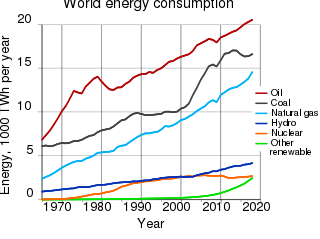
The environmental impact of the energy industry is significant, as energy and natural resource consumption are closely related. Producing, transporting, or consuming energy all have an environmental impact. Energy has been harnessed by human beings for millennia. Initially it was with the use of fire for light, heat, cooking and for safety, and its use can be traced back at least 1.9 million years. In recent years there has been a trend towards the increased commercialization of various renewable energy sources. Scientific consensus on some of the main human activities that contribute to global warming are considered to be increasing concentrations of greenhouse gases, causing a warming effect, global changes to land surface, such as deforestation, for a warming effect, increasing concentrations of aerosols, mainly for a cooling effect.
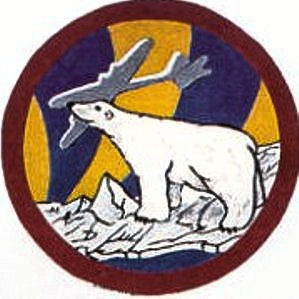
John Murray Mitchell Jr. was an American climatologist. As a United States Air Force weather officer in Alaska from 1952 to 1955, he investigated and named the Arctic haze. He served with the United States Weather Bureau and successor agencies from 1955 until his retirement in 1986, and was a prominent member of the National Academy of Sciences and the National Science Foundation. The Mitchell Glacier was named after him.

The Climate and Clean Air Coalition to Reduce Short-Lived Climate Pollutants (CCAC) was launched by the United Nations Environment Programme (UNEP) and six countries—Bangladesh, Canada, Ghana, Mexico, Sweden, and the United States—on 16 February 2012. The CCAC aims to catalyze rapid reductions in short-lived climate pollutants to protect human health, agriculture and the environment. To date, more than $90 million has been pledged to the Climate and Clean Air Coalition from Canada, Denmark, the European Commission, Germany, Japan, the Netherlands, Norway, Sweden, and the United States. The program is managed out of the United Nations Environmental Programme through a Secretariat in Paris, France.

The Dr. Neil Trivett Global Atmosphere Watch Observatory is an atmospheric baseline station operated by Environment and Climate Change Canada located about 6 km (3.7 mi) south south-west of Alert, Nunavut, on the north-eastern tip of Ellesmere Island, about 800 km (500 mi) south of the geographic North Pole.
Mace Head Atmospheric Research Station is located on the West Coast of Ireland in Carna, and is one of the longest running mercury recording stations in the world. The stations location is highly important as it is far away from neighbouring cities to ensure no pollutants interfere with recordings, and its location is also highly important as it is ideal for studying the atmosphere under Northern Hemispheric and European conditions. The station has the dual status of being a World Meteorological Organization (WMO) Global Atmosphere Watch (GMO) station and a European Monitoring and Evaluation Program (EMEP) supersite. Mace Head research and monitor the climate and atmospheric composition, focusing on aerosol-cloud interactions and mercury readings.

Julia Yvonne Schmale is a German environmental scientist. She is a specialist in the micro-physical makeup of the atmosphere, in particular aerosols and their interaction with clouds. She is a professor at EPFL and the head of the Extreme Environments Research Laboratory (EERL). She is a participant in the Multidisciplinary drifting Observatory for the Study of Arctic Climate (MOSAiC) expeditions.
Brynjulf Ottar (1918–1988) was a Norwegian atmospheric chemist who served as the first director of the Norwegian Institute for Air Research. In the 1970s, his work on the long-range transport of air pollution helped to alert the world to the problem of acid rain; later, he was one of the first scientists to describe the mechanism of global distillation, by which pollutants travel from mid-latitude parts of Earth to the Arctic.
